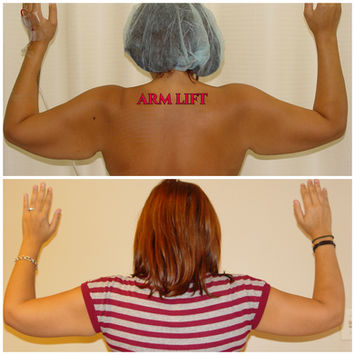18819 Delaware St., Huntington Beach, CA 92648
714-500-0050
Exceptional Results, Naturally Beautiful!

All About Arm Lift
Introduction to Arm Lift
Arm Lift (Brachioplasty) is a surgical procedure to tighten the upper arms by removing excess skin and fat. If you or your friend are considering Arm Lift or if you are only interested in more information about the procedure, please call us at (714) 500-0050 for a consultation with Dr. Luu Doan. You can also email us by clicking here to schedule a consultation or to get answers to any of your questions regarding the procedure.
Excess hanging skin and fat in the upper arms most commonly results from massive weight loss and aging. What bothers women most about the hanging skin and fat is the unattractive appearance in sleeveless shirts, especially when waving their arms. There are also functional issues involved. Excess skin and fat of the upper arms causes heaviness and easy fatigue of the arms when lifting. It is also difficult to find shirts and dresses that fit well.
The surgical treatment for excess skin and fat of the upper arms is the Arm Lift procedure also known as brachioplasty. Brachioplasty is the plastic surgical treatment for the upper arm called the brachium. The operation is an excellent procedure to eliminate hanging skin and fat of the upper arm. The trade-off is a longitudinal scar hidden on the inside of the upper arm from the elbow crease to the arm pit. The benefit is a tighter, slimmer upper arm that tapers down towards the forearm more proportionately.
Arm Lift Surgery
The Arm Lift surgery is an outpatient procedure performed under general anesthesia in our medicare-accredited, state-of-the-art Newport Coast Surgical Center. The operation takes approximately two hours to perform. The patient is monitored by an anesthesiologist throughout the procedure.
The operation begins with an incision along the inside of the upper arm extending from the arm pit to the elbow crease. The skin is then dissected off the muscle and freed up as far back as possible. A wide crescent of skin and fat is then removed from the back of the upper arm. A drainage tube is placed under the skin and exiting the back of the elbow. The skin is then closed with absorbable sutures.
Only a thorough and candid discussion between you and Dr. Doan can determine the best surgical options for you. Doctor Doan will discuss with you in detail every step of the procedure and he will review with you the possible complications of the operation.
Recovery From Arm Lift Surgery
Recovery from an Arm Lift procedure is remarkably less painful than one might expect. You will be prescribed medication for pain and nausea. You will also be given antibiotics to prevent infection. The arm should be kept elevated on pillows for the first several days to lessen the swelling. An elastic arm compression garment is worn for six weeks to minimize swelling and to help with tightening of the skin. You should be up and about the next day to prevent blood clots from developing in the veins of the legs. Stitches are dissolvable and do not need to be removed. Swelling takes up to two months to completely resolve and there should be no bruising. Most patients can return to work by two weeks after surgery. Sensation may take 6-12 months to return completely. By 3 months after surgery, most patients are highly satisfied with their results. Doctor Doan and his staff will guide you through the entire recovery period to make sure that it is as smooth as possible.
Complications of Arm Lift Surgery
If you are a healthy candidate with no pre-existing disorders or diseases which may inhibit healing, the general risks of Arm Lift surgery are very low. However, since it is indeed surgery, there are inherent risks you must consider before choosing to undergo a procedure such as this. Potential complications associated with Arm Lift surgery may include the following:
-
Bleeding: Bleeding is quite rare after this procedure and may require a return to the operating room to control the bleeding.
-
Infection: Skin infection is also rare but may result from bacteria tracking along the drainage tube into the wound or from bacteria in the axilla. It can easily be treated with antibiotics.
-
Seroma: If drainage tubes are not used or if they are taken out too soon after surgery, then fluid can build up underneath the skin. This would require aspiration in the office.
-
Keloid Scars: This is usually hereditary and is based on your genetic potential for healing. This results from scar tissue forming outside the edges of the incision. It can result in thick, elevated, dark, or wide scars. A scar revision may be attempted to improve the appearance of the scar.
-
Skin Separation: This results from infection of the skin or too much tension on the incision from too much skin being removed. It generally results in a keloid scar.
-
Numbness of the Skin: You should expect prolonged numbness of the inside of the upper arm. It may take 12 to 18 months for the sensation to return. However, there may be some permanent loss of sensation.













